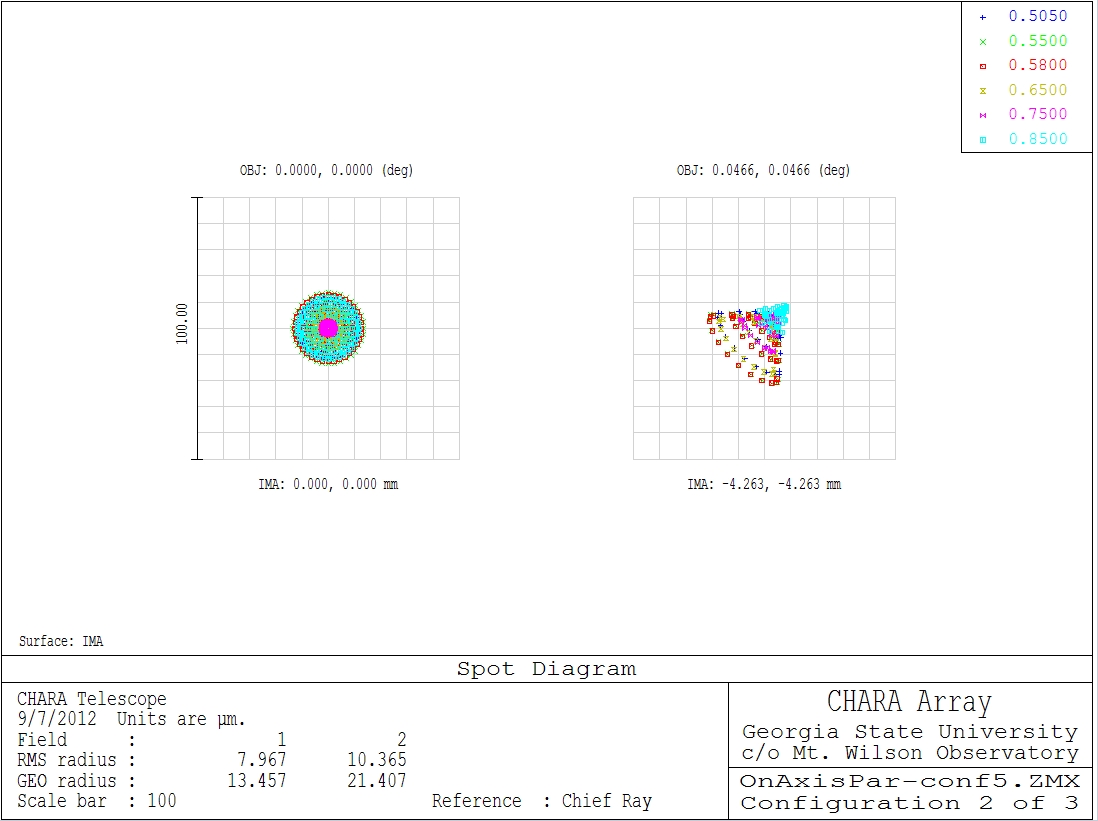Sidebar
This is an old revision of the document!
Table of Contents
Acquisition System
Optical Layout
Coma on the Fold Mirror
Assuming perfect optics, images at the fold mirror have coma 2 arcmin from on-axis (2.3mm from the center) that amounts to a 90% encircled energy radius of 14 microns, or 0.72 arcsec. This coma is linearly proportional to distance off-axis.
Existing Acq Camera with 1:1 Relay Option
Camera Selection
An ideal acquisition camera should enable both fast and slow readout, with dark current lower than typical sky noise. The current acquisition camera is a camera with a BNC connector made by Watec (the 120N?). The short axis of the field of view is 5.7mm (? to confirm). An alternative camera is the (uncooled) DMK.AU02CCD camera from Imaging Source. This has a short axis of 4.76mm, and a diagonal of 7.96mm. The CCD datasheet for this larger format sensor is here, and the more sensitive and smaller version MJI is familiar with is here. This smaller version has definitely been seen to be sky noise limited (i.e. not dark or readout noise) for ~1 sec exposures. Gig-E versions are available.
Laszlo: Currently we use Astrovid Stellacam II video cameras for both imege acquisition and for the finder. This camera looks very much like a Watec camera only a bit larger. I suspect it is made by Watec. The Astrovid uses Sony ICX418AL CCD while the DMK camera uses Sony ICX205AL CCD. Both CCDs are Type 1/2, that is 8 mm diagonally. According to the datasheets the sensitivity of the ICX418AL and ICX205AL are 1100 mV and 450 mV, respectively. The Astrovid dark signal is 1 mV while the DMK dark signal is 16 mV. Thus the Astrovid is more sensitive than the DMK. The Astrovid has an analog output and needs a frame grabber. This is not ideal. It would be nice to have digital output. The USB output of the DMK is not ideal either because we either use the WFS computer to handle the acquisition finder cameras or we need a bunch of repeaters because USB 2 is limited to 5 m cable length and the bunkers are rather 30 m away.
Ideally, I'd use a camera like the Astrovid with network interface if such thing existed.
Mike: The real issue is exposure time. The sensitive Watecs used at SUSI and for AAT guiding only work at 30 Hz, so are readout noise limited. A CCD packaged so that it is forced to have a 30 Hz readout has a factor of ~5.5 higher readout noise after averaging those frames than something that enables 1Hz readout.
Laszlo: You have a point there…but the situation is not as bad because the ICX418 has 2x the pixel size and four times the signal per pixel readout than the ICX205. So in this respect the SNR(DMK)/SNR(ASTROVID)=1.45 at 1 sec integration. I think the best would be to compare them on the telescope.
C-mount Lens Option
There are commercial C-mount macro lenses, e.g. the Computar MLM3X-MP lens from e.g. RMA. This would have the following properties:
- Fold-mirror to lens front distance of 90mm.
- Lens length of 80mm.
- When used at 0.4x Macro, 0.6“ pixels and a short dimension of 9.6 arcmin (a 15.8 arcmin diagonal). Problem: the camera can not be used at 0.4x Macro with an f/4.5 input : this only works at 1.0x zoom. A faster (e.g. f/2) camera would have to be used at 0.5x Macro.
- Assuming 50% QE, 50% throughput and a 0.4 micron bandwidth, 10^3 photons/s on a 15th mag star (i.e. definitely sky-limited observing with ~1s exposures).


